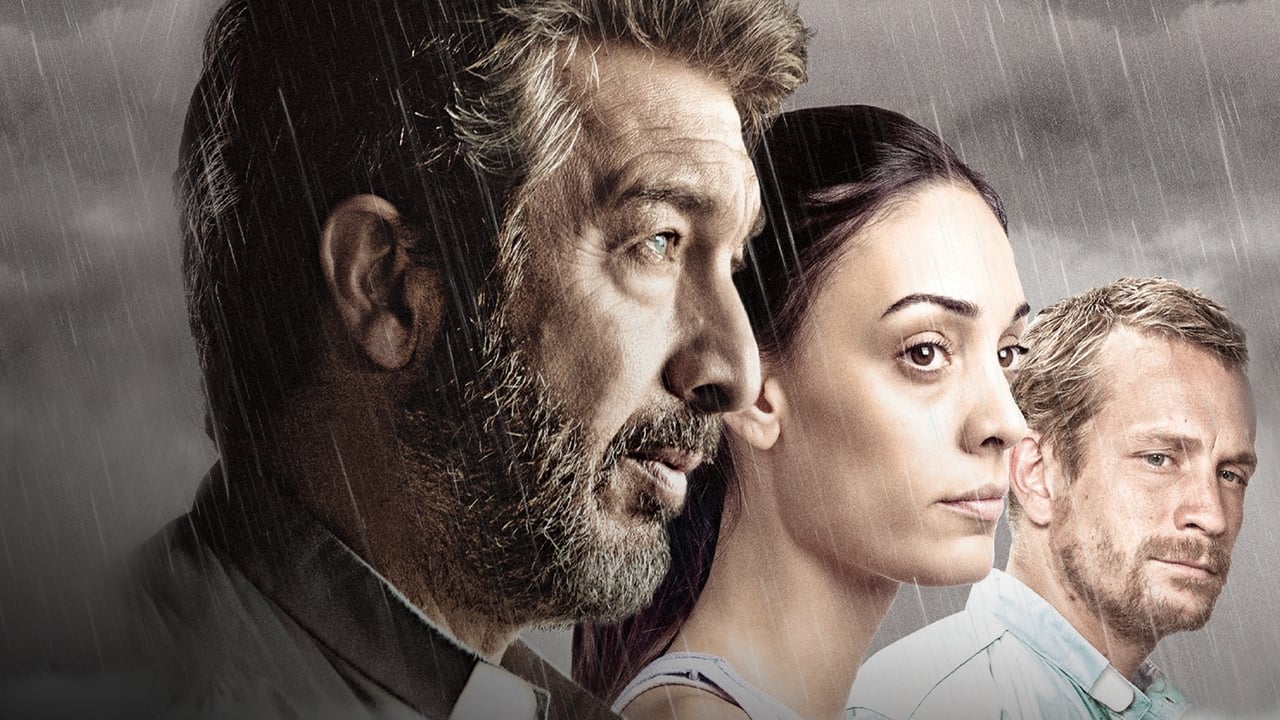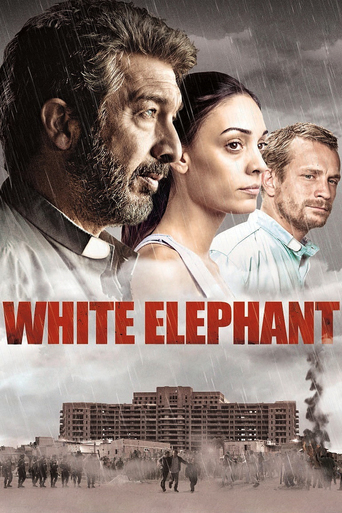

I like the storyline of this show,it attract me so much
... View MoreAmateur movie with Big budget
... View MoreAbsolutely Fantastic
... View MoreThrough painfully honest and emotional moments, the movie becomes irresistibly relatable
... View MoreThere are two dominant symbols in the film that represent its major themes: the unfinished hospital that is the white elephant of the title and the murder of priests.An unfinished white building that was supposed to be a hospital and carried the ambitions of various Argentinian leaders to be the best hospital on the continent, has become the centre of a Buenos Aires slum. Surrounding the building are more make shift dwellings that house people and the community's chapel. On public land outside, building has begun on a project to provide new permanent homes for the slum dwellers, a community centre and, at the centre, a new church. This building is soon abandoned by the development company after its employees' wages fail to materialise. Who is responsible for paying the wages is not established amidst the bureaucracy. The community's anger when the work ceases boils over into a violent confrontation with the police that ends in fatality.A 'white elephant' is an expression for the evident presence of something ignored or not spoken about. As a symbol it is prevalent throughout the film and is a leitmotif. Other white elephants include the wealth of the Catholic church contrasted with its parishioners; the question of why a priest, as a representative of faith, cannot marry or have sexual relations yet can preach on these matters; the summary justice visited on the slum dwellers by authorities that mirrors the criminal behaviours they are there to prevent; and, the biggest white elephant of them all, why don't the elected leaders act? Why are the slum dwellers left poor? If they can make homes from nothing then why can't homes be made for them?The incomplete hospital represents the shifting and unsettled politics of Argentina with investment being provided and then withdrawn as the country's elected leaders changed. Thus the film can be viewed as a comment on the turbulent political sands of South America and the divide between wealthy and poor as much as on Argentina and Buenos Aires.The other symbol of the film is Father Carlos Mugica, a real life figure who, like the character of Father Julian (Ricardo Darin), hailed from an affluent background and devoted his religious life to the poor. Mugica was assassinated for his efforts by an anticommunist political group and this serves as a reminder of the high price leaders of the poor and disenfranchised can pay when society's paymasters feel threatened.The film opens in another South American country, Peru, where another poor community are being massacred as the authorities hunt for their priest, Father Nicolas (Jeremie Renier), who manages to elude capture. We do not learn what Fr Nicolas has done to invite such wrath but given what we see of Fr Nicolas later he was probably campaigning in an active way for his parishioners betterment, which was at odds with the authorities' wishes. During his convalescence he is visited by his colleague and confessor Father Julian who persuades him to return with him to Buenos Aires and help with the work the church are engaged in at the slum. Fr Nicolas's introduction to the reality of slum life hits him on his first night when the quiet is interrupted by gun fire and a pounding song on the soundtrack underlines how busy and noisy will be his new environment.The film's strength is its depiction and evocation of slum life. The director, Pablo Trapero, filmed in an actual Buenos Aires slum and many of the minor players and extras were from the local population. In spite of the poverty and crime the slum is shot in a way that shows its quirky beauty, the care of the people for their environment and its vitality.Contrasted to the pulsating slum life are the sterile and hierarchical meetings held by the church leaders with Fr Julian. One of the film's debates, explored via Fr Julian and Nicolas, is the issue of faith and its relationship, if any, with sinful behaviour. Remote and privileged, the religious leaders follow an orthodoxy that cannot adapt to the challenges faced by their priests in the slum and in this they fail their priests who are left to their own devices amidst the ensuing chaos. The actions of Fr Julian and Nicolas might be viewed as sinful but it seems equally sinful not to act, as is the decision made by the church leaders.One major criticism of the film is that its desire to be faithful to slum life makes the film very busy and more like a series of vignettes than a story following one or two characters. Indeed the main characters become symbols themselves rather than fleshed out people. On my first viewing I was left dissatisfied with the film as a result. A second viewing helped greatly as I was no longer concerned with plot and could focus instead on the themes and how characters and events contributed to them. Overall I think the film is a good one with strong acting, superb sense of place and time and a cracking soundtrack that contrasts popular music with orchestral pieces composed by Michael Nyman that are like dirges contributing to a prevailing sadness. Throughout the film mourns, without sentimentality, the plight of the slum dwellers and the losses in their lives and of those who try to help, as well as the loss of individual aspirations and hopes.Someone has described Trapero's films as muscular and that is a good way to view this film. It is strong and dynamic and encourages one to think about it and what is being portrayed.
... View MoreArgentinean director Pablo Trapero brings to the screen a very dark seemingly hopeless disparity between the rich and the poor. Written by Trapero along with Alejandro Fadel, Martín Mauregui and Santiago Mitre, the story will burn on the viewer's mind the hypocrisy of disparity between the rich and the poor.The film opens in the Peruvian jungle where Father Nicolás (Jérémie Renier) witnesses the brutal massacre of his friends and congregation while he alone survives, leaving a profound sense of guilt for not having also died in the catastrophe. Father Nicolás's beloved friend and confessor Father Julián (Ricardo Darín) brings Nicolás to the "Villa Virgin", a 'favela' like shantytown in the slums of Buenos Aires near an abandoned huge project for a hospital that was started decades ago in Buenos Aires, seen today as a typical "white elephant", a useless structure that now houses the poverty stricken inhabitants. Drugs provide the major business in this ghetto. Assault weapons and firearms can be found almost everywhere. Add all that to the precarious living conditions and this sort of hell on earth is not even fit for anyone to endure. The two priests work tirelessly to help the local people. Julián uses his political connections to oversee the construction of a hospital. Nicolás remains deeply troubled from his experience in the jungle, but he does find comfort in Luciana (Martina Gusman), a young, attractive, atheist social worker. As Nicolás' faith weakens, tension and violence between the slum drug dealing cartels grows. And when work on the hospital is halted by ministerial decree, the faith of the inhabitants of Villa Virgin is shattered, and Nicolás discovers he has been called by Julián to assume his role of parish priest as Julián is coping with an undiagnosed neurological disease. It is a test of wills, a test of faith, and a sense of being crushed by the politics of Argentina.Because of the setting in the filthy and decrepit slum the visuals become confusing with the cinematography by Guillermo Nieto attempting to take in too much visual information to the point of confusing the story line. But the musical score by Michael Nyman is brilliant and enhances the film tremendously. The three major actors - Darin, Renier, and Gusman - are outstanding in very difficult roles. If the audience is left with a sense of the futility the people of the slums face daily, then the film has accomplished its mission. In Spanish with English subtitles. Grady Harp
... View MoreThe evils of society at large, are examined by Argentine director Pablo Trapero. He sets his story in the "favela" like shantytown that sprouted near an abandoned huge project for a hospital that was started decades ago in Buenos Aires, seen today as a typical "white elephant", an useless structure that houses today the marginalized inhabitants to the nearby slum. Drugs are a lucrative business within this ghetto. Assault weapons and fire arms can be found almost everywhere. Add all that to the precarious living conditions and this sort of hell on earth is not even fit for anyone to live.There is a prologue to the story. Father Julian, who has met Nicolas as they were studying for the priesthood, goes into the Peruvian jungle to rescue his friend from the massacre which he miraculously survived, carrying the guilt for not having died himself. Julian brings Nicolas to Buenos Aires to the church where he is tending to the poor inhabitants of the shantytown. Unknown to Nicolas, Julian has been diagnosed with a strange neurological disease, which is never mentioned. In a way, Julian has reached to Nicolas to be his successor, once he is not around.Nicolas encounters all kinds of human tragedy in the area. A young social worker, Luciana, is another source for bringing hope to the desperation of the people in the shantytown. It does not take long before Nicolas realizes the attraction he feels for the young woman, who also has fallen passionately in love with the young priest. As was rages within the confines of the slum town, bringing tragedy into the area. Julian has to do wonders in order to feed the needy while silently suffering the disease that is robbing his life.The screenplay was a collaboration by the director, Martin Mauregui, Alejandro Fadel and Santiago Mitre. The idea is not exactly new, as this has been the subject of movies of such impact as Fernando Meirelles' "City of God" as well as others that have examined the misery, despair and cruelty found in places such as the one depicted in this film. Where Mr. Trapero succeeds is in the handling of the cast. Ricardo Darin is a natural whose work gets better all the time. Jeremie Renier has some good moments, although he seems a bit out of place. Martina Gusma, who is Mrs. Trapero in real life, makes the most of her Luciana. Guillermo Nieto's cinematography is crude, something that was required to make the movie work. Michael Nyman's film score does not go well with the images on the screen.
... View MoreThe perfect portray of human hypocrisy. I guess the actual message in this movie is that nothing really ends, nor the struggle for a better life or the evil that keeps people from getting a better life.Some other reviewer stated this kind of story had already been told... Well has it?. Not this one in particular, I think the characters are quite real. Both main characters and extras have done a wonderful job keeping it real, nothing i have seen in Argentinian films for a while.The shots are beautiful and seem to capture very well the actual landscape of the "villas". Music on the other hand doesn't live up to the most dramatic moments in the film, and personally I think it could have been improved.To sum up "Elefante blanco" is definitely a movie to be watched, and mostly a message to be heard.
... View More